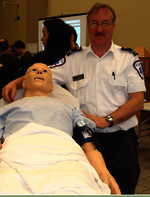A New IT Experience from a HAL with a Difference
In 2001: A Space Odyssey the world was introduced to an Artificial Intelligence (AI) that wanted to survive and run things its own way. The HAL in this story is related to IT, but instructors are necessary to provide the intelligence. HAL is the name of a full size, wireless portable adult mannequin simulator that is used to provide simulation for nursing and paramedic students at John Abbott College. HAL allows the students to experience situations in a safe and nonthreatening setting. This promotes integration of the theoretical knowledge and practical skills development within the relevant programs allowing students to critically think in a first aid or hospital type environment.

Judith Findlay, John Abbott College Nursing Department with HAL at the Dawson IT Fair, December 2009.
HAL is controlled wirelessly by a teacher. A sufficiently trained instructor can pre-program a scenario into HAL via a palette wirelessly connected to the mannequin. This program will simulate initial conditions for the patient such as: heart rate (including being able to take the pulse of the patient in the appropriate locations), blood pressure, respiratory rate, eye response, lung sounds, heart sounds, airway obstruction and tongue swelling. The teacher can then wirelessly signal HAL to simulate a reaction to student interventions at a distance that allows students to feel that they are acting independently. There are also a number of additional limbs to simulate wounds or pressure ulcers. It is also possible for Hal to have a tracheotomy, a chest tube, intravenous line, foley catheter and receive injections at selected sites.

Jeff Brown, John Abbott College Pre-Hospital Emergency Program with HAL at the Dawson IT Fair, Dec 2009.
Scenarios can be adapted to any student level. For example a first semester nursing student can be asked to assess the vital signs of the patient. An advanced standing nursing student (5th or 6th semester) could be given the medications prescribed for the patient and, based on their assessment, determine if these medications should be administered or a physician called as there may be an issue.
A standard situation may be for a student to be told to enter the room and conduct a patient assessment after reading the chart. The student may ask the patient questions, and the patient will respond either by the instructor speaking through a headset or through the use of pre-programmed responses in the computer. As well, the instructor can change any of the vital signs described above to respond to a caregiver action to allow assessment of the student’s real time response to a situation.

Students at John Abbott College Nursing Program using HAL – Fall 2009
The website of the manufacturer indicates that HAL can be used during transport for training, so that simulations dealing with auto accidents, rushing HAL from the scene to the ER, to the ICU, while students, using real monitoring and resuscitation equipment, diagnose and treat his condition are a possibility for the future. The Pre-Hospital Emergency Care Program, a new program at John Abbott College, uses HAL and shares resources.
HAL is relatively new to the John Abbott teaching faculty and has been used in limited situations during the fall semester of 2009. I tested HAL out with 14 students in the first semester, 7 students in the third semester and 2 students in the 5th semester and all were eager for the opportunity to use HAL even on their own time. Jeff Brown, who teaches in the Pre-Hospital Emergency Care Program at John Abbott College has also used HAL in his program. The students were active and engaged, and they found it fun. They really only had positive comments to make about their experience in using this new technology.
From the teachers’ viewpoints, the learning curve to operate HAL is easy. I came in one time before using the simulation with students to practice. The manufacturer will offer courses on its operation if necessary. Although HAL’s cost is significant, around $30,000, I am convinced that as more instructors in the pre-hospital emergency and nursing faculties become proficient in its use, it will become a valuable augmentation to the clinical experience available to students.

